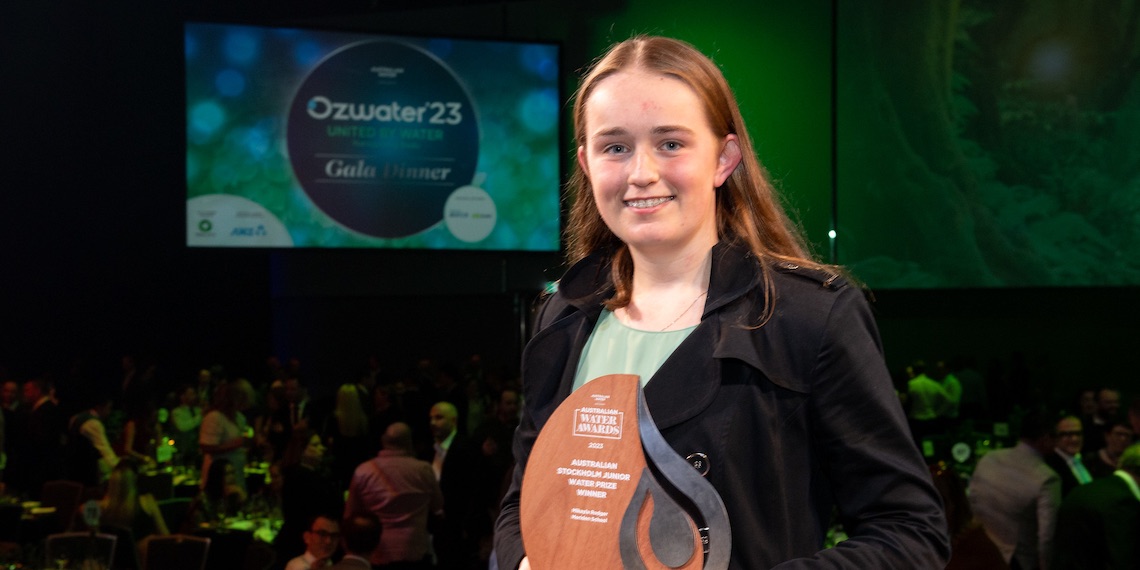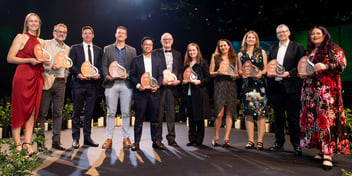Australian junior science talent set to hit the world stage

One bright young Australian scientist is set to take the world stage at the Stockholm Junior Water Prize in Sweden next month.
Announced at the Ozwater’23 Gala Dinner, Mikayla Rodger won the 2023 Australian Stockholm Junior Water Prize, automatically putting her in the running to take the international accolade.
Rodger was celebrated for her innovative project, the SolarCyanoSlayer – a solution designed to tackle multiple cyanobacteria triggers within waterways.
“It all began with a science project at school where I decided to do a little bit more than the standard project. It was a big opportunity for me, and with the support of my science teachers at Meriden I was inspired to do water research and look at ways to preserve the environment,” she said.
“I started out by breaking down global water concerns. I looked at contaminants in different forms. I saw some news articles online about blue-green algae and decided this would be where I would try to help.
“The idea was to use things I could find in my everyday life to create a simple solution to an otherwise very complex issue. I found a niche issue that I could target locally.”
While signing up to participate in the Australian Junior Stockholm Prize was coincidental, Rodger said water issues and caring for the environment are things she is very passionate about.
“The importance of water is hard to put into words as it’s central to everything. Water is priceless; it's the most essential commodity on Earth so we need to make sure it's clean and accessible for all people. I've always been taught growing up how significant water is and that it's going to be my generation’s responsibility as emerging leaders and custodians to protect our water,” she said.
“But I also think it's saddening that a lot of our water problems are man-made. For instance, with cyanobacteria, it's the combination of global climate change and human-induced nutrient enrichment that has made the bacteria an ecological threat.
“Cyanobacteria was actually one of the first organisms on the planet, responsible for producing a large proportion of the world’s oxygen. This was something really important to consider when making my design.
"I chose to reduce the potency of cyanobacteria growth, preventing devastating bloom events. But the solution does not prevent cyanobacteria from growing. It’s a crucial part of nature. I think finding that balance when working with the environment is really important.”
The SolarCyanoSlayer
In terms of how the prototype was developed, Rodger said she started by asking a lot of questions about the growth conditions for cyanobacteria.
“Every great solution always starts with a few questions. So, I questioned the causes of cyanobacteria, I questioned the growth conditions that lead to exponential bloom events, and I questioned the limitations of current technology which fail to diminish this threat,” she said.
“This led me to identify the three main conditions that need to be targeted. These consisted of eutrophication, which is the build up of phosphorus and nitrogen in the waterway. This happens frequently on farming dams as the water is enriched with the runoff from agricultural fertiliser.
“Another issue is low-dissolved oxygen. This increases the catalytic abilities of cyanobacteria and helps speed up their cellular processes, which is how all the toxins are released. The third issue is stagnation, when water is low flowing or not moving at all.”
Rodger said that she then pinpointed a niche area to target: farming dams which often have these three conditions, and thus are susceptible to major bloom events. During a review of solutions already designed to help reduce bloom events she noticed most designs only try to tackle one of these issues.
“One of the major flaws in current designs is that they usually only try to deal with one of the issues that contribute to big blooms, rather than targeting all of them,” she said.
“For example, one solution I reviewed didn’t work because it was only a circulation system. It didn't filter out the minerals or improve the amount of oxygen. Similarly, there are aeration systems that increase the oxygen, but don’t move the water around or provide any filtration.
“My aim was to target all three issues to create a more effective solution.”
Rodger said she particularly enjoyed figuring out the most effective way of mitigating each issue while also using recycled materials.
“The SolarCyanoSlayer is solar powered. As cyanobacteria grow in warmer conditions when there is a lot of sun, solar energy is more efficient as it aligns with the conditions in which the design will be applied,” she said.
“Solar energy powers a pump, which moves the water around to prevent stagnation. The solar panels also add oxygen to the water, which dramatically improves the quality of any waterway and prevents hypoxic conditions from forming.”
“My solution also has a bio-filtration system that removes phosphorus and nitrogen. But the filter is in its early stages – it is a part of my prototype that I am working on improving ahead of attending the Stockholm Junior Water Prize in Sweden.”
“I was dedicated to using materials available around me, so my prototype was eco-friendly and quite cheap to build: old hose pieces and pipes and even used plants in the filtration system. There is a lot we can do with resources we would otherwise discard.”
Jet-setting science
Looking back on winning the Australian Stockholm Junior Water Prize, Rodger said it was “a surreal experience”.
“When I was informed that I had won I nearly dropped my phone because I was so surprised. Receiving the award showed how even a little project can be really significant. It was a local project that I was very passionate about, and to see it recognised in this way has been absolutely incredible,” she said.
“Even just going to Ozwater’23 was amazing. I loved hearing about all the other projects, and it was inspiring to hear about all the ingenious approaches to solving our water problems.”
And, with Rodger set to join other international finalists at the global award in Stockholm in August, she said she can’t wait to learn about what other students have been working on, too.
“I am most looking forward to meeting other people my age who are similarly determined to find solutions for water issues and hearing all about what they have been doing, and why that work is significant to them in their country,” she said.
“While cyanobacteria has big implications here in Australia, it’s also a global issue. I’m interested to see how other students have progressed with their own local challenges.
“Being involved in the prize has been a big learning experience. I would definitely encourage other students to get involved in the Stockholm Junior Water Prize. It's a really motivating experience where you get the opportunity to learn all about the water sector, our current global challenges, and be inspired by the local, national, and international research which is making a difference on a global scale.
"The people create an atmosphere that is so inspiring, and they’ve taught me that if you're passionate about an issue, even as a young person you can make real change. I want to pass on this message to any other students and encourage them to find their passion because that passion is priceless, and once you find it the possibilities are endless.”

